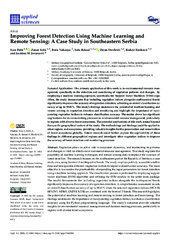Приказ основних података о документу
Improving Forest Detection Using Machine Learning and Remote Sensing: A Case Study in Southeastern Serbia
| dc.creator | Potić, Ivan | |
| dc.creator | Srdić, Zoran | |
| dc.creator | Vakanjac, Boris | |
| dc.creator | Bakrač, Saša | |
| dc.creator | Đorđević, Dejan | |
| dc.creator | Banković, Radoje | |
| dc.creator | Jovanović, Jasmina M. | |
| dc.date.accessioned | 2023-12-14T14:34:23Z | |
| dc.date.available | 2023-12-14T14:34:23Z | |
| dc.date.issued | 2023 | |
| dc.identifier.issn | 2076-3417 | |
| dc.identifier.uri | http://gery.gef.bg.ac.rs/handle/123456789/1719 | |
| dc.description.abstract | Vegetation plays an active role in ecosystem dynamics, and monitoring its patterns and changes is vital for effective environmental resource management. This study explores the possibility of machine learning techniques and remote sensing data to improve the accuracy of forest detection. The research focuses on the southeastern part of the Republic of Serbia as a case study area, using Sentinel-2 multispectral bands. The study employs publicly accessible satellite data and incorporates different vegetation indices to improve classification accuracy. The main objective is to examine the practicability of expanding the input parameters for forest detection using a machine learning approach. The classification process is performed by employing support vector machines (SVM) algorithm and utilising the SVM module in the scikit-learn package. The results demonstrate that including vegetation indices alongside the multispectral bands significantly improves the accuracy of vegetation detection. A comprehensive assessment reveals an overall classification accuracy of up to 99.01% when the selected vegetation indices (MCARI, RENDVI, NDI45, GNDVI, NDII) are combined with the Sentinel-2 bands. This research highlights the potential of machine learning and remote sensing in forest detection and monitoring. The findings underscore the importance of incorporating vegetation indices to enhance classification accuracy using the Python programming language. The study’s outcomes provide valuable insights for environmental resource management and decision-making processes, particularly in regions with diverse forest ecosystems. | |
| dc.publisher | Basel : MDPI | |
| dc.rights | openAccess | |
| dc.rights.uri | https://creativecommons.org/licenses/by/4.0/ | |
| dc.source | Applied Sciences | |
| dc.subject | vegetation detection | |
| dc.subject | remote sensing | |
| dc.subject | Python | |
| dc.subject | machine learning | |
| dc.subject | classification accuracy | |
| dc.subject | Sentinel-2 | |
| dc.title | Improving Forest Detection Using Machine Learning and Remote Sensing: A Case Study in Southeastern Serbia | |
| dc.type | article | |
| dc.rights.license | BY | |
| dc.citation.volume | 13 | |
| dc.citation.issue | 14 | |
| dc.citation.spage | 8289 | |
| dc.citation.rank | M22 | |
| dc.identifier.wos | 001037897700001 | |
| dc.identifier.doi | 10.3390/app13148289 | |
| dc.identifier.scopus | 2-s2.0-85166194694 | |
| dc.identifier.fulltext | http://gery.gef.bg.ac.rs/bitstream/id/3576/applsci-13-08289-v2.pdf | |
| dc.type.version | publishedVersion |


